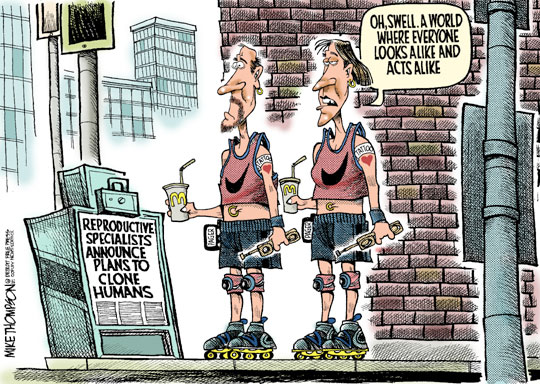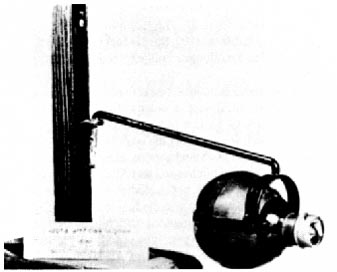| |
 |
|
|
|
| |
Last update on January 20, 2005 |
|
C2 The scientific background: then and nowby Jan & Philipp R.
Report about Cloning a human being (comparing the 1920´s with now):
The easiest way to describe cloning
Definitions: a) The isolation and artificial multiplication of DNA. The repeated multiplication or reproduction of genetically identical cells or organisms. b) Creating a copy of an individual by using a single cell out of this individual. The clones will receive all the personal traits of the original organism. - nothing “new”, just a copy
Method of cloning: Egg cell (ovum) of a woman à Removal of the nucleus à Cell is empty à Cell of the human being, which will be cloned à DNA of this cell into the empty cell à Growth in a test tube and further in the womb
Aims of cloning and problems in the past: - important molecule is missing à oversized organs à death of the embryo - every gene could contain a defect molecule or one could be missing à for example growth-retarding [even in the puberty one defect gene could appear (i.e..: concerning the growth of the hair)] An Italian scientist seemed to be the first, who is able to clone a baby, but British scientists are the first, who are able to clone the perfect (without the past problems) baby, but it would live only by the help of drugs and transfusions. Egg cell (ovum) of a woman --> Removal of the nudeus --> Cell is empty --> Cell of the to be cloned human being --> DNA of this cell into the empty cell --> Growth in a test tube and further in the womb + -
- important molecule is missing --> oversized organs --> death of the embryo - every gene could contain a defect molecule or one could be missing --> for example growth-retarding - no one of 1000 embryos survived in an experiment with cloning Rhesus-monkeys British scientists are the first, who are able to clone the perfect baby, but it would live only by the help of drugs and transfusions. This problem will be solved within 30 years.
The scientific background of Huxley’s “Brave new World” The most important component to be mentioned, with regard to the “Biological Revolution” of the early 20th centuries, is the development of “AI” (artificial insemination). But with this actual knowledge, the scientists were not able do practice “AI” on human beings.
Historical Facts until the late 19th century: In the course of time, more and more scientists gave their attention to artificial insemination. Until the late 19th century, AI was viewed as purely a scientific matter and not of any practical use. In 1897, after testing effects on animals, Walter Heap came to the conclusion that it is possible to divide one ejaculate amongst several females. Now, saw advantages in manipulating farm animals. In 1900 E. Ivanoff started some experiments on horses in Russia. He was the first to successfully artificially inseminate cattle and sheep. In the following years, many advances were made in the field of AI to the point that cooperative associations were formed in the late thirties proving that AI had become a reality in the agricultures field. “Tools” to improve the effect of AI had been developed in 1914 by G. Amantea. He invented the first artificial vagina which had been used for dogs. Later it would be adapted for use in all other species. In 1930´s buffered nutrient solutions were developed for the dilution of semen.
First artificial Vagina, by Amantea
Important development in Gene-Techniques: 1926: Thomas Hunt Morgan published “The theory of the gene”, the culmination of work on the physical basis for Mendelian genetics based on breeding studies and optical microscopy. Hermann Muller discovered that X-rays induce genetic mutations in fruit flies 1.500 times more quickly than under normal circumstances. This discovery provided researches with a way to induce mutations, an important tool for discovering what genes do on their own. 1928: Fredrick Griffiths noticed that a rough type of bacterium changed to a smooth type when an unknown “transforming principle” from the smooth type was present. Sixteen years later, Oswald Avery identified that “transforming principle” as DNA.
|
The cell is filled with DNA.
Dolly…first animal which was successfully cloned (Feb. 97)
|
 Aldous Huxley -
Brave New World
Aldous Huxley -
Brave New World



